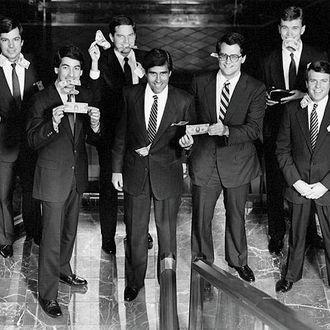
Dan Primack is all over the counter-narrative to the controversy surrounding today’s Boston Globe story about how Mitt Romney, who claimed to have left Bain Capital in 1999 to run the Salt Lake City Olympics, was actually employed as Bain’s CEO and sole shareholder until 2002.
Primack has the offering documents from a private equity fund Bain raised in 2000 that lists eighteen managers of the fund — the people who were making the direct decisions about what the firm invested in, and how much it invested. Romney’s name isn’t on it.
The distinction between what the Obama campaign is saying (that Romney lied about when he stopped running Bain Capital and therefore is responsible for decisions that led to the outsourcing of jobs post-1999) and the reality to be drawn from Primack’s document stash (that Romney might have been “running” Bain Capital during that period, in a technical sense, but wasn’t actively managing its investments) is a small but very important point that cuts to the heart of the way private equity firms are managed.
The terms “private equity firm” and “private equity fund” are often used interchangeably, but they actually mean different things.
Many private equity firms have multiple funds inside them, each with specific investment criteria. For example, a firm might have a fund that invests solely in European companies, or a venture fund that invests in start-ups, or a real estate fund that buys and sells big buildings. Each of those funds can be managed — meaning, have decisions made about what to do with the money inside them — by different people.
The CEO of the entire private equity firm — in this case, Mitt Romney — may be responsible, in a legal and fiduciary sense, for anything that results from the investments of a firm’s individual funds. But he may not be “responsible” – in the sense of having direct operational control – for what the managers of those funds actually choose to do.
Compare it to the leadership structure of the New York Times. As chairman and CEO, Arthur Sulzberger Jr. “runs” the company. He is listed on official SEC filings as the person in charge of The New York Times Company, and he is ultimately responsible to the paper’s shareholders — and the legal powers that be — if something goes wrong.
But Sulzberger doesn’t “run” the actual, paper-and-pixels Times in any operational sense of managing the newsroom, assigning beats, or dictating the placement of stories. Those responsibilities fall to Jill Abramson, the paper’s executive editor. As CEO and chairman, Sulzberger earns money from the activities of the paper, and he can be named in lawsuits that originate on the editorial side. But if a Times reporter made a massive error in a story, Sulzberger could reasonably place the blame at Abramson’s feet, since control of the paper’s content is (at least, ideally) hers alone.
What Mitt Romney is claiming, essentially, is that during the period between February 1999 and 2002, when he was running the Olympics, his involvement with Bain Capital’s actual investments was roughly equivalent to Sulzberger’s involvement with the editorial side of the Times. (Even less, actually, because Romney was on leave.) He was “running” Bain, in a nominal and legal sense, and he was making money from its funds.
But when it came to choosing which companies the funds should invest in, and how to operate the ones Bain acquired, it’s entirely plausible that Romney’s involvement after 1999 was limited to signing documents, getting a few brief updates from his lieutenants, and then going back to worrying about bobsleds or ski jumps or whatever.
That seems odd, if you’re the kind of person who thinks of CEOs as active managers who roll up their sleeves every day, hire and fire employees, make decisions about new products, and serve as the ultimate authority on the day-to-day activities of a company. But at Bain — as the 2000 offering documents show — things worked differently. Romney, during his leave of absence, looks to have been a Potemkin CEO, in charge without actually being in charge.
Does that mean, per the Obama campaign, that Romney can be “blamed for bankruptcies and layoffs from Bain investments” until he formally left Bain in 2002? In a legal and political sense, certainly. By keeping his titles and Bain shares during his leave of absence (probably in the hopes that he would return to Bain after the Olympics), he allowed himself to be kept on the hook for anything, good or bad, that the firm did while he was off in Salt Lake City.
That’s a move he and his campaign managers, who have been reduced to hair-splitting over the definition of “managing,” will likely regret for a long, long time.
But technically speaking, it doesn’t mean that his campaign’s version of events is a bold-faced lie.





























